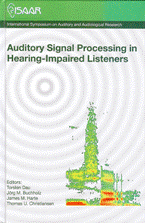Evidence-based hearing aid algorithms
Abstract
Hearing aid (HA) algorithms contain a large number of tuning parameters that need to be optimized with respect to the expected patient satisfaction. Here we report on a new fitting-engineering approach where patient measurements (audiogram, listening tests etc.) are transferred without loss of information to optimal values for HA tuning parameters. Our approach is rooted in Bayesian decision theory and takes properly account of inconsistencies in the measured patient data. The presented approach is envisioned to assist the experienced HA dispenser in the challenging task of tting a HA algorithm to a specific patient in a limited time.
References
Bondy, J., Coughlin, M., Whitmer, B., and Dittberner, A. (2007). “Assessing sound quality of feedback algorithms with auditory models,” ISAAR 2007 conference, Helsingor, Denmark.
Bradley, R. A., and Terry, M. E. (1952). “Rank analysis of incomplete block designs. I. The method of paired comparisons,” Biometrika, 39, 324–345.
De Vries, B., Heskes,T. M., and Dijkstra, T. M. H. (2006). “Bayesian Incremental Utility Elicitation with Application to Hearing Aids Personalization,” Valencia/ISBA 8th World Meeting on Bayesian Statistics , Benidorm, Spain.
Dillon, H. (2001). “Hearing aids,” Boomerang Press, Australia. ISBN 1-58890-052-5.
Kates, J. M., and Arehart, K. H. (2004). “A metric for evaluating speech intelligibility and quality in hearing aids,” J. of the Acoust. Soc. of America, Volume 116, Issue 4, pp. 2536-2537.
Train, K. (2003). “Discrete choice models with simulation,” Cambridge University Press.
Additional Files
Published
How to Cite
Issue
Section
License
Authors who publish with this journal agree to the following terms:
a. Authors retain copyright* and grant the journal right of first publication with the work simultaneously licensed under a Creative Commons Attribution License that allows others to share the work with an acknowledgement of the work's authorship and initial publication in this journal.
b. Authors are able to enter into separate, additional contractual arrangements for the non-exclusive distribution of the journal's published version of the work (e.g., post it to an institutional repository or publish it in a book), with an acknowledgement of its initial publication in this journal.
c. Authors are permitted and encouraged to post their work online (e.g., in institutional repositories or on their website) prior to and during the submission process, as it can lead to productive exchanges, as well as earlier and greater citation of published work (See The Effect of Open Access).
*From the 2017 issue onward. The Danavox Jubilee Foundation owns the copyright of all articles published in the 1969-2015 issues. However, authors are still allowed to share the work with an acknowledgement of the work's authorship and initial publication in this journal.


